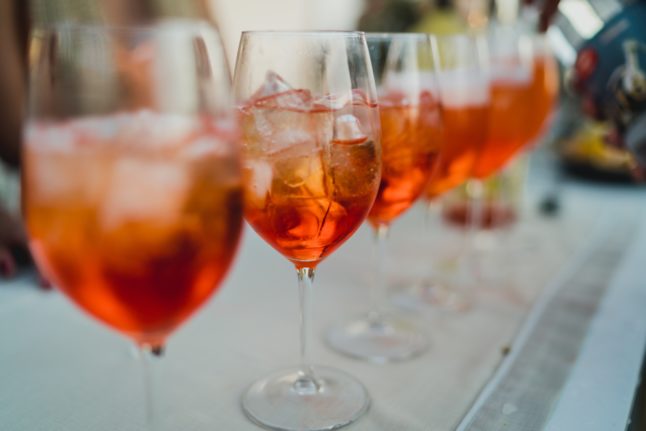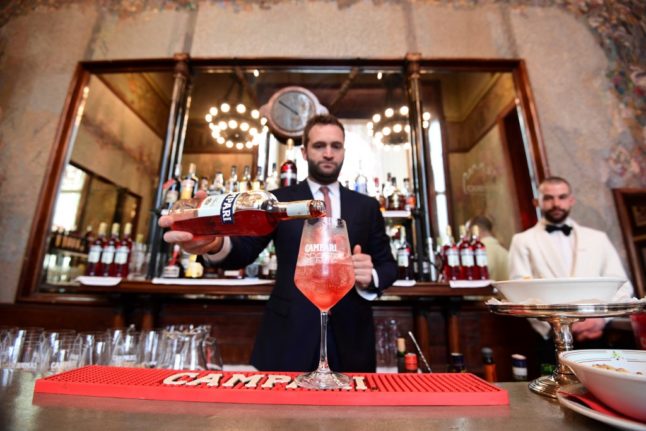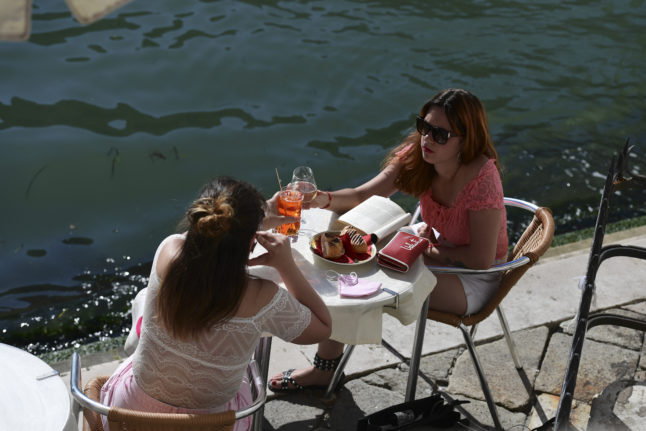Spritz
Venice wins all the prizes for being the home of the spritz: the jewel in Italy’s summertime daisy crown and one of the country’s most popular exports.
To first-time customers, the sweet-and-bitter combo can taste unpleasantly like a poisoned alcopop. Stick with it, however, and you’ll soon learn to appreciate this sunset-coloured aperitif, which has come to feel synonymous with summer in Italy.
The most common version is the bright orange Aperol Spritz, but if this starts to feel too sweet once your tastebuds adjust then you can graduate to the dark red Campari Spritz, which has a deeper and more complex flavour profile.

Negroni
If you’re too cool for the unabashedly flamboyant spritz but want something not too far off flavour-wise, consider the Negroni.
It’s equal parts gin, vermouth and Campari – though if you want a more approachable version, you can order a ‘Negroni sbagliato’ – literally a ‘wrong’ Negroni – which replaces the gin with sweet sparkling Prosecco white wine.
Served with a twist of orange peel and in a low glass, the Negroni closely resembles an Old Fashioned, and is equally as stylish. A traditional Negroni may be stirred, not shaken, but it’s still the kind of cocktail that Bond would surely be happy to be seen sipping.
Crodino
Don’t fancy any alcohol but still crave that bitter, amaro-based aftertaste?
A crodino might be just what you’re after. With its bright orange hue, it both looks and tastes very similar to an Aperol Spritz – so much so that you might initially ask yourself whether you’ve in fact been served the real thing.
Similar in flavour are soft drinks produced by the San Pellegrino brand; bars that don’t have any crodino on hand will often offer you ‘un San Pellegrino’ as a substitute. These drinks are usually available in multiple flavours like blood orange, grapefruit, or prickly pears.

Chinotto
Much like the crodino, the chinotto is another distinctive bitter Italian aperitivo drink.
With its medium-dark brown colouring, however, the chinotto bears more of a resemblance to Coca Cola than to the spritz, leading to its occasionally being designated as the ‘Italian Coca Cola’.
In reality far less caramelly and much more tart than coke, the chinotto has its detractors, and the fact that we’re having to describe its flavour here means it clearly hasn’t set the world alight since it was first invented in the 1930s (it was subsequently popularised by San Pellegrino, which became its main Italian producer).
If you’re looking for another grown-up tasting alternative to an alcoholic aperitivo, however, the chinotto might just be the place to look.
Bellini
What’s not to love about the bellini?
Its delicate orange and rose-pink tones are reminiscent of a sunset in the same way as a spritz, but with none of the spritz’s complex and contradictory flavours.
A combination of pureed peach and sugary Prosecco wine, the bellini’s thick, creamy texture can almost make it feel smoothie or even dessert-like. It’s a sweet and simple delight, with just a slight kick in the tail to remind you it’s not a soft drink.
Shakerato
Not a fan of drinks of the fruity/citrusy/marinated herby variety?
If caffeine’s more your thing, Italy has an answer for you in the caffe shakerato: an iced coffee drink made with espresso, ice cubes, and sugar or sugar syrup.
That might not sound inspired at first, but hear us out: the three ingredients are vigorously mixed together in a cocktail shaker before the liquid is poured (ice cube-free) into a martini glass, leaving a dark elixir with a delicate caramel coloured foam on top.
You couldn’t look much more elegant drinking an iced coffee than sipping one of these.



 Please whitelist us to continue reading.
Please whitelist us to continue reading.
Aperol actually comes from Padua. For an authentic Venetian spritz, order a “Select Spritz”. Select is a bright red aperitivo with a gingery flavour.